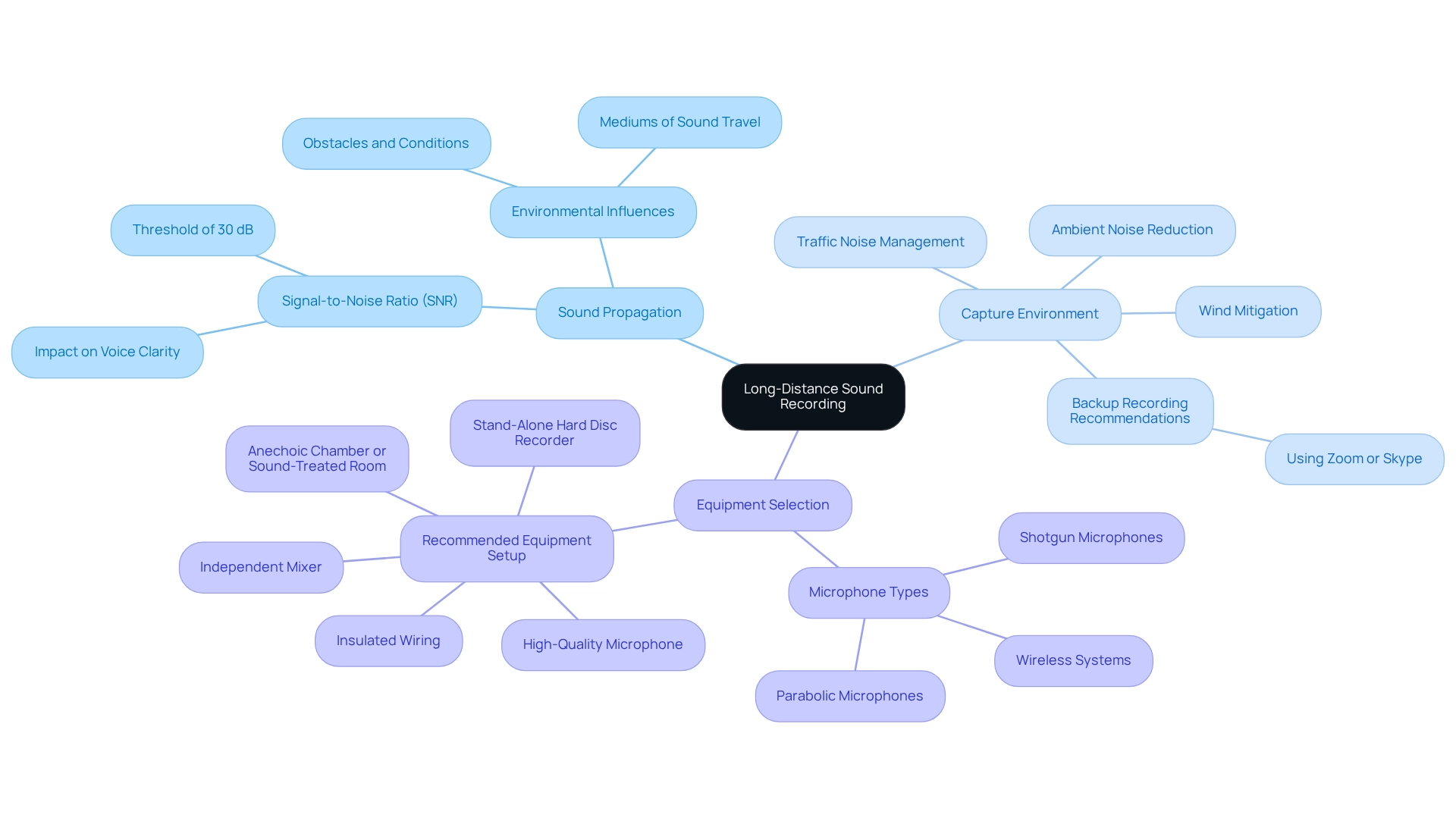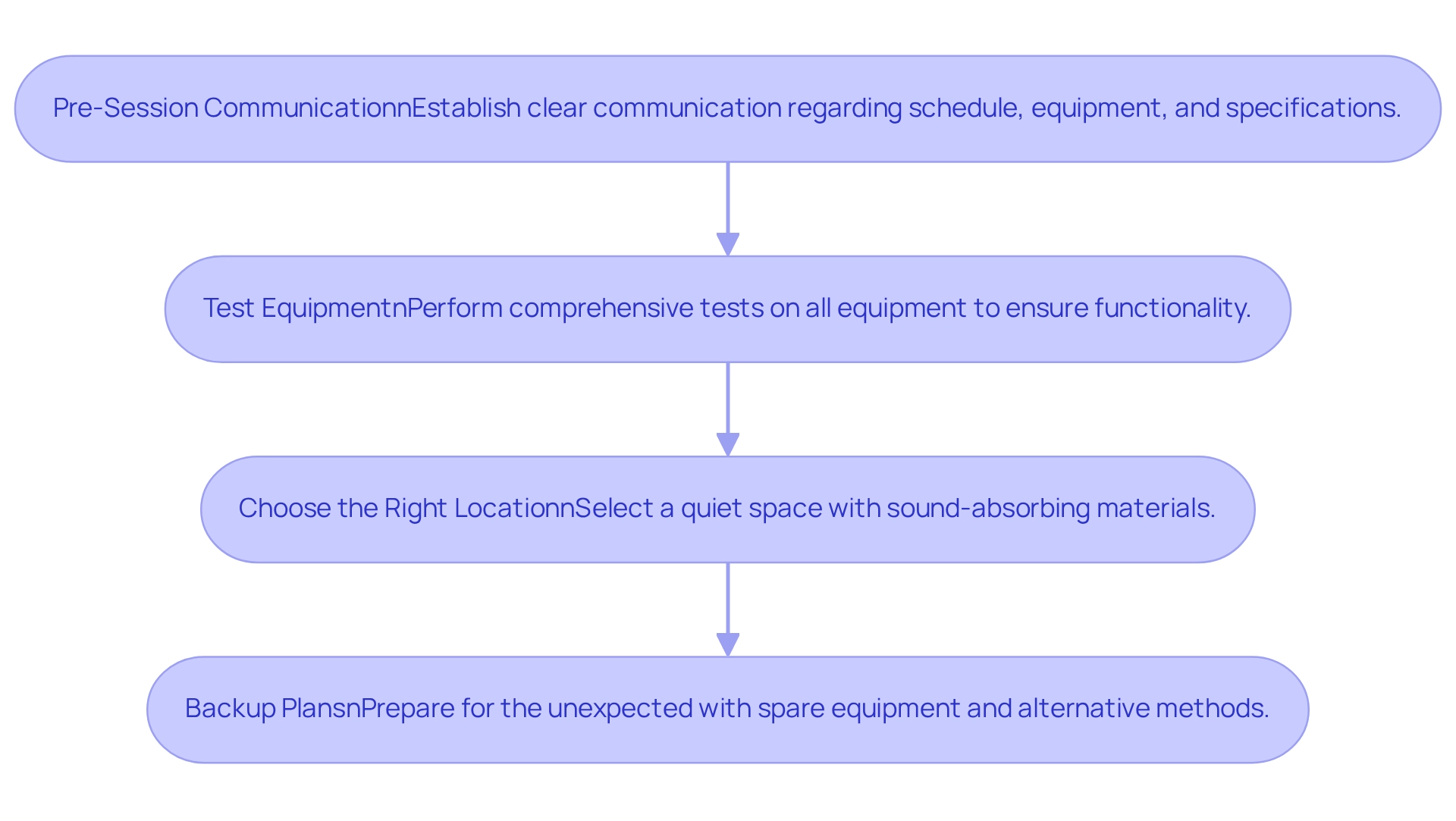4 Key Practices for Long Distance Sound Recording Success

Overview
The article outlines four key practices for achieving success in long-distance sound recording:
- Understanding sound propagation
- Utilizing advanced equipment
- Meticulous planning
- Effective post-production techniques
Each of these practices addresses the unique challenges of capturing high-quality audio over distances.
Understanding sound propagation is crucial, as it influences how sound travels and is perceived. By grasping these principles, sound engineers can make informed decisions that enhance audio clarity. Utilizing advanced equipment allows for superior sound capture, offering advantages such as improved fidelity and versatility in various environments.
Meticulous planning ensures that all aspects of the recording session are considered, from location scouting to scheduling. This preparation is vital for minimizing unforeseen challenges that can arise during the recording process. Finally, effective post-production techniques refine the audio, elevating the final product’s professionalism.
In summary, these practices emphasize the importance of proper equipment selection, environmental considerations, and thorough preparation. By implementing these strategies, sound engineers can significantly enhance the clarity and professionalism of their recordings.
Introduction
In the realm of audio production, long-distance sound recording presents unique challenges that can significantly impact a project’s success. Capturing clear audio amidst background noise and selecting the appropriate equipment are just a few intricacies that demand a comprehensive understanding of various concepts. As technology progresses, mastering sound propagation, microphone selection, and environmental considerations becomes crucial for anyone striving for high-quality recordings.
This article explores the foundational principles, advanced techniques, and post-production strategies essential for elevating long-distance audio capture. By ensuring that every note and nuance resonates with clarity and professionalism, we aim to equip you with the knowledge needed to enhance your audio projects.
Understand the Basics of Long-Distance Sound Recording
The process of long distance sound recording involves capturing audio from significant distances, which presents unique challenges such as sound clarity, background noise, and the selection of appropriate equipment. Understanding key concepts is essential for effective sound capture:
-
Sound Propagation: Sound travels through various mediums, and its characteristics can be greatly influenced by environmental conditions and obstacles. For instance, when the signal-to-noise ratio (SNR) falls below 30 dB, environmental noise can severely impact voice clarity. Therefore, it is crucial to consider these factors during the capture process, as familiarity with different types of microphones is vital for successful long distance sound recording. Shotgun microphones, parabolic microphones, and wireless systems each offer distinct advantages and disadvantages based on the audio environment. Selecting the right microphone can enhance sound capture and minimize unwanted noise.
-
Capture Environment: The environment in which you capture sound plays a pivotal role in the overall quality. Elements such as wind, traffic, and ambient noise can negatively affect clarity. Understanding how to mitigate these factors is essential for achieving high-quality audio outputs. Additionally, it is advisable to save a backup on platforms like Zoom or Skype during double-ender sessions to ensure the reliability of your captures. By mastering these fundamental concepts of long distance sound recording, you will be better equipped to navigate the complexities of capturing audio across various environments. Regularly updating your content can also enhance visibility on podcast platforms, underscoring the importance of staying current in the field.

Utilize Advanced Equipment and Techniques for Optimal Sound Quality
To achieve optimal auditory performance in long distance sound recording, consider the following equipment and techniques:
-
Microphone Selection: High-quality microphones specifically designed for long distance sound recording are essential. Shotgun microphones are excellent for isolating focused sound, while parabolic microphones effectively capture audio from a broader area, making them suitable for various environments. Investing in these microphones ensures that you have the right tools for your audio needs.
-
Windshields and Pop Filters: Windshields significantly reduce wind noise, and pop filters mitigate plosive sounds, resulting in clearer audio. Brands like Maono, Stedman, and Blue offer reliable options that enhance audio performance. Mic pop filters are versatile, suitable for home studios, professional setups, and on-the-go recordings. Utilizing these tools is crucial in competitive podcasting, where exceptional recordings can create a notable impact.
-
Interfaces and Mixers: Professional interfaces and mixers enhance clarity and provide greater control over audio levels. These devices are vital for achieving a refined final product, allowing modifications that cater to specific capturing conditions. Their use ensures that your audio stands out in quality.
-
Techniques: Implementing methods such as the 3:1 rule for microphone placement helps avoid phase issues and ensures clear sound capture. Incorporating timestamps can improve navigation for listeners in episodes featuring different segments. Experimenting with various placements may reveal the ideal configuration for your unique audio situation, and by employing advanced gear and techniques for long distance sound recording, you can significantly enhance the quality of your captures, ensuring clarity and professionalism in your sound. As highlighted in the case study ‘Embracing Passion in Podcasting,’ when podcasters embrace their passion, it fosters authenticity and connection with listeners, leading to a more enjoyable podcasting journey.

Plan and Prepare for Successful Long-Distance Recording Sessions
Successful long distance sound recording requires meticulous planning and preparation. Here are essential steps to ensure a smooth process:
-
Pre-Session Communication: Establish clear communication among all participants regarding the recording schedule, equipment requirements, and technical specifications. As Tara Parachuk, Senior Manager of Brand Communications, emphasizes, ‘Ensuring a clear and focused brand voice across all media channels is crucial,’ which applies equally to audio sessions. This proactive approach minimizes misunderstandings and sets the stage for a productive session.
-
Test Equipment: Before the documentation, perform a comprehensive test of all equipment. Verify microphone levels, connectivity, and sound quality to identify and resolve any potential issues ahead of time. Statistics indicate that common difficulties encountered in long distance sound recording often arise from equipment failures, making this step essential.
-
Choose the Right Location: Opt for a quiet space with minimal background noise. Using sound-absorbing materials can significantly improve the acoustic environment, leading to clearer audio.
-
Backup Plans: Always prepare for the unexpected by having a backup plan in place. This may involve keeping spare equipment available or having alternative capturing methods ready to deploy. The case study titled “Planning for Success” highlights that effective planning bridges the gap between vision and execution, ensuring focus and productivity.
By implementing these strategies, you can significantly increase the likelihood of a successful long distance sound recording session, ensuring that all participants are aligned and equipped for optimal performance. Top5.com serves as a trusted resource for consumers seeking reliable information, making it an excellent guide for navigating the complexities of remote recording.

Implement Effective Post-Production Techniques for Enhanced Audio Quality
Post-production is a crucial stage for refining and enhancing recorded sound. Here are some effective techniques to elevate your sound quality:
-
Noise Reduction: Advanced audio editing software like Audacity or Adobe Audition features sophisticated noise reduction tools. These algorithms, such as spectral subtraction and wavelet transformation, significantly enhance signal-to-noise ratio (SNR) parameters. This enhancement is essential for attaining clearer sound in different recording scenarios, even in challenging environments with noise levels around 20 dB.
-
Equalization (EQ): Applying EQ is essential for balancing frequencies and enhancing clarity. By boosting specific frequencies, voices sound more prominent, while cutting others helps eliminate muddiness. Mastering EQ techniques is crucial for achieving professional-quality sound, especially in film production, where emotional impact is paramount. Tim Cain, co-owner of Gemini LSV, reflects on this journey, stating, ‘I never considered entering the sound industry. I wanted to be a rock star,’ highlighting the passion that drives many in the industry.
-
Compression: Utilize compression to manage the dynamic range of your sound. This technique ensures that softer sounds are audible while preventing louder sounds from distorting, creating a more balanced listening experience.
-
Final Mixing: Focus on the overall blend of your sound. Adjust levels, panning, and effects to create a polished final product. Effective mixing can transform raw recordings into cohesive sound experiences that resonate with listeners. A case study titled ‘Mastering Essential Sound Effects’ emphasizes that mastering sound effects such as EQ, compression, reverb, delay, and distortion is crucial for enhancing the emotional impact of films. By mastering these effects, filmmakers can create professional-grade audio experiences that significantly improve the overall standard of their films, especially when implementing post-production techniques that enhance the quality of long distance sound recording, ensuring it meets professional standards and delivers clear, impactful sound.

Conclusion
Navigating the complexities of long-distance sound recording requires a solid understanding of several foundational principles and advanced techniques. Mastering key concepts such as sound propagation, microphone selection, and the impact of the recording environment significantly improves audio clarity and minimizes unwanted noise. The choice of equipment, including high-quality microphones and effective accessories like windshields and pop filters, plays a crucial role in capturing clear sound. Additionally, professional audio interfaces and mixers ensure a polished final product.
Preparation is equally vital for successful recording sessions. Establishing clear communication, testing equipment beforehand, selecting an appropriate location, and having backup plans can mitigate common challenges and enhance the overall experience. These proactive strategies set the stage for capturing high-quality audio that resonates with listeners.
The post-production phase cannot be overlooked. Effective techniques such as noise reduction, equalization, and compression are essential for refining recordings. By focusing on the final mix and employing advanced audio editing tools, the quality of long-distance recordings can reach professional standards, ultimately resulting in clear and impactful sound.
Achieving excellence in long-distance audio capture is a multifaceted endeavor that combines preparation, technological know-how, and creative post-production techniques. By embracing these principles, anyone can elevate their audio projects, ensuring that each recording is not only technically sound but also engaging and resonant with its audience.
Frequently Asked Questions
What are the main challenges of long distance sound recording?
The main challenges include sound clarity, background noise, and the selection of appropriate equipment.
How does sound propagation affect long distance sound recording?
Sound propagation is influenced by environmental conditions and obstacles, which can greatly affect audio clarity. A low signal-to-noise ratio (SNR) below 30 dB can severely impact voice clarity.
What types of microphones are best for long distance sound recording?
Shotgun microphones, parabolic microphones, and wireless systems are commonly used, each offering distinct advantages and disadvantages depending on the audio environment.
Why is the capture environment important in sound recording?
The capture environment significantly affects audio quality, as elements like wind, traffic, and ambient noise can negatively impact clarity.
What should be done to ensure sound quality during recording sessions?
It is essential to understand how to mitigate environmental noise factors and to save backups on platforms like Zoom or Skype during double-ender sessions for reliability.
How can one enhance visibility on podcast platforms?
Regularly updating content can enhance visibility on podcast platforms, highlighting the importance of staying current in the field of sound recording.





